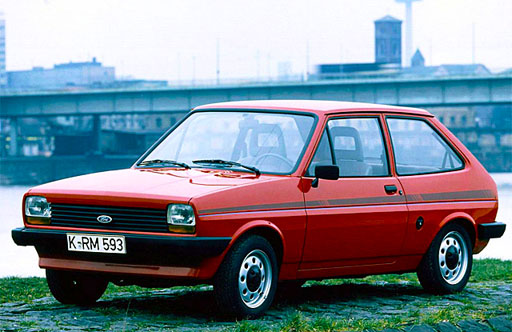 Preliminary sketches of the body of the small Ford come from the early years 70. The final shape was given to it by designers from the American headquarters of the concern with the participation of specialists from the Italian styling studio Ghia. The design of the new car was developed in Europe. The first front-wheel drive Ford with a transversely located engine joined the "3.5-3.7 m" club that was then forming on the market. (Length), to which the m.in already belonged.: Fiat 127, Opel Kadett City, Renault 5 and Volkswagen Polo.
Preliminary sketches of the body of the small Ford come from the early years 70. The final shape was given to it by designers from the American headquarters of the concern with the participation of specialists from the Italian styling studio Ghia. The design of the new car was developed in Europe. The first front-wheel drive Ford with a transversely located engine joined the "3.5-3.7 m" club that was then forming on the market. (Length), to which the m.in already belonged.: Fiat 127, Opel Kadett City, Renault 5 and Volkswagen Polo.
The official premiere of fiesta took place in June 1976 r., initially in three engine versions (1,0 i 1,1 dm3, 30+40 kW). The adopted solutions of mechanical assemblies were subordinated to the simplicity of construction and low production costs. The four-cylinder power units had a crankshaft with three main bearings and a head made of light alloys, camshaft placed in the fuselage. McPherson struts are used in the front suspension, in the rear, a rigid beam guided by longitudinal rods and sprung with coil springs, cooperating with pan-hard stick. Disc brakes were fitted to the front wheels, at the rear drum. Three doors allowed convenient access to the spacious interior. Until 80% the volume of the vehicle is intended for passengers and their luggage. The car was created in Ford factories in Spain, Germany and the United Kingdom.
A year after the debut, varieties were introduced 1.3 i 1.6 (for export to the USA). W 1981 r. the sports variant of the XR2 demonstrated (1,6 dm3, 62 kW). After two years, the body line was retouched, mainly in its front part, modernized cabin design and expanded engine range, m.in. o diesel unit (1,6 dm3, 40 kW).
In March 1989 r. the second generation Fiesta was presented, now also available in a five-door variant, the following year, turbocharging was proposed, and in high season 1992/93 Zetec family engine (1.8 16V).
From August 1995 r. Fiesta of the third series is offered, with new power units, modified suspension, reinforced body structure and rounded silhouette. This model at the beginning 1999 r. has undergone another modernization. The exterior styling is subordinated to Ford's preferred New Edge Design style, improved suspension geometry, also minor changes were made to the interior.